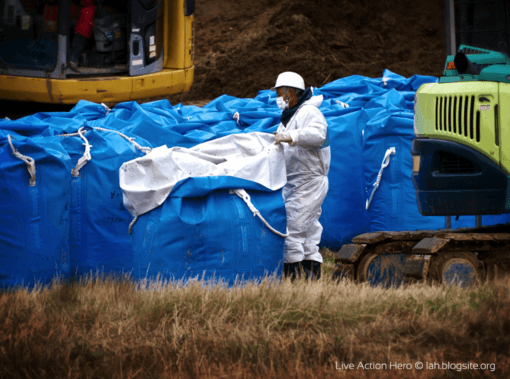Fukushima’s Radiation Will Poison Food “for Decades,” Study Finds
ENVIRONMENT, 26 Jun 2017
22 Jun 2017 – Three of the six reactors at Japan’s Fukushima-Daiichi complex were wrecked in March 2011 by an earthquake and tsunami. The destruction of emergency electric generators caused a “station blackout” which halted cooling water intake and circulation. Super-heated, out-of-control uranium fuel in reactors 1, 2, and 3 then boiled off cooling water, and some 300 tons of fuel “melted” and burned through the reactors’ core vessels, gouging so deep into underground sections of the structure that to this day operators aren’t sure where it is. Several explosions in reactor buildings and uncovered fuel rods caused the spewing of huge quantities of radioactive materials to the atmosphere, and the worst radioactive contamination of the Pacific Ocean ever recorded. Fukushima amounts to Whole-Earth poisoning.
Now, researchers say, radioactive isotopes that were spread across Japan (and beyond) by the meltdowns will continue to contaminate the food supply for a very long time.
According to a new study that focused on “radiocaesium” — as the British call cesium-134 and cesium-137 — “food in Japan will be contaminated by low-level radioactivity for decades.” The official university announcement of this study neglected to specify that Fukushima’s cesium will persist in the food chain for thirty decades. It takes 10 radioactive half-lives for cesium-137 to decay to barium, and its half-life is about 30 years, so C-137 stays in the environment for roughly 300 years.
The study’s authors, Professor Jim Smith, of the University of Portsmouth, southwest of London, and Dr. Keiko Tagami, from the Japanese National Institute of Radiological Sciences, report that cesium-caused “radiation doses in the average diet in the Fukushima region are very low and do not present a significant health risk now or in the future.”
This phraseology deliberately conveys a sense of security — but a false one. Asserting that low doses of radiation pose no “significant” health risk sounds reassuring, but an equally factual framing of precisely the same finding is that small amounts of cesium in food pose a slightly increased risk of causing cancer.
This fact was acknowledged by Prof. Smith in the June 14 University of Portsmouth media advisory that announced his food contamination study, which was published in Science of the Total Environment. Because of above-ground atom bomb testing, Prof. Smith said, “Radioactive elements such as caesium-137, strontium-90 and carbon-14 contaminated the global environment, potentially causing hundreds of thousands of unseen cancer deaths.”
No less an authority than the late John Gofman, MD, Ph.D., a co-discoverer of plutonium and Professor Emeritus of molecular and cell biology at the University of California, spent 50 years warning about the threat posed by low doses of radiation. In May 1999, Gofman wrote, “By any reasonable standard of biomedical proof, there is no safe dose, which means that just one decaying radioactive atom can produce permanent mutation in a cell’s genetic molecules. My own work showed this in 1990 for X rays, gamma rays, and beta particles.”
The Fukushima-borne cesium in Japan’s food supply, and in the food-web of the entire Pacific Ocean, emits both beta and gamma radiation. Unfortunately, it will bio-accumulate and bio-concentrate for 300 years, potentially causing, as Dr. Gofman if not Dr. Smith might say, hundreds of thousands of unseen cancer deaths.
_______________________________________
 John LaForge is a Co-director of Nukewatch, a peace and environmental justice group in Wisconsin, and edits its newsletter.
John LaForge is a Co-director of Nukewatch, a peace and environmental justice group in Wisconsin, and edits its newsletter.
Go to Original – counterpunch.org
DISCLAIMER: The statements, views and opinions expressed in pieces republished here are solely those of the authors and do not necessarily represent those of TMS. In accordance with title 17 U.S.C. section 107, this material is distributed without profit to those who have expressed a prior interest in receiving the included information for research and educational purposes. TMS has no affiliation whatsoever with the originator of this article nor is TMS endorsed or sponsored by the originator. “GO TO ORIGINAL” links are provided as a convenience to our readers and allow for verification of authenticity. However, as originating pages are often updated by their originating host sites, the versions posted may not match the versions our readers view when clicking the “GO TO ORIGINAL” links. This site contains copyrighted material the use of which has not always been specifically authorized by the copyright owner. We are making such material available in our efforts to advance understanding of environmental, political, human rights, economic, democracy, scientific, and social justice issues, etc. We believe this constitutes a ‘fair use’ of any such copyrighted material as provided for in section 107 of the US Copyright Law. In accordance with Title 17 U.S.C. Section 107, the material on this site is distributed without profit to those who have expressed a prior interest in receiving the included information for research and educational purposes. For more information go to: http://www.law.cornell.edu/uscode/17/107.shtml. If you wish to use copyrighted material from this site for purposes of your own that go beyond ‘fair use’, you must obtain permission from the copyright owner.
